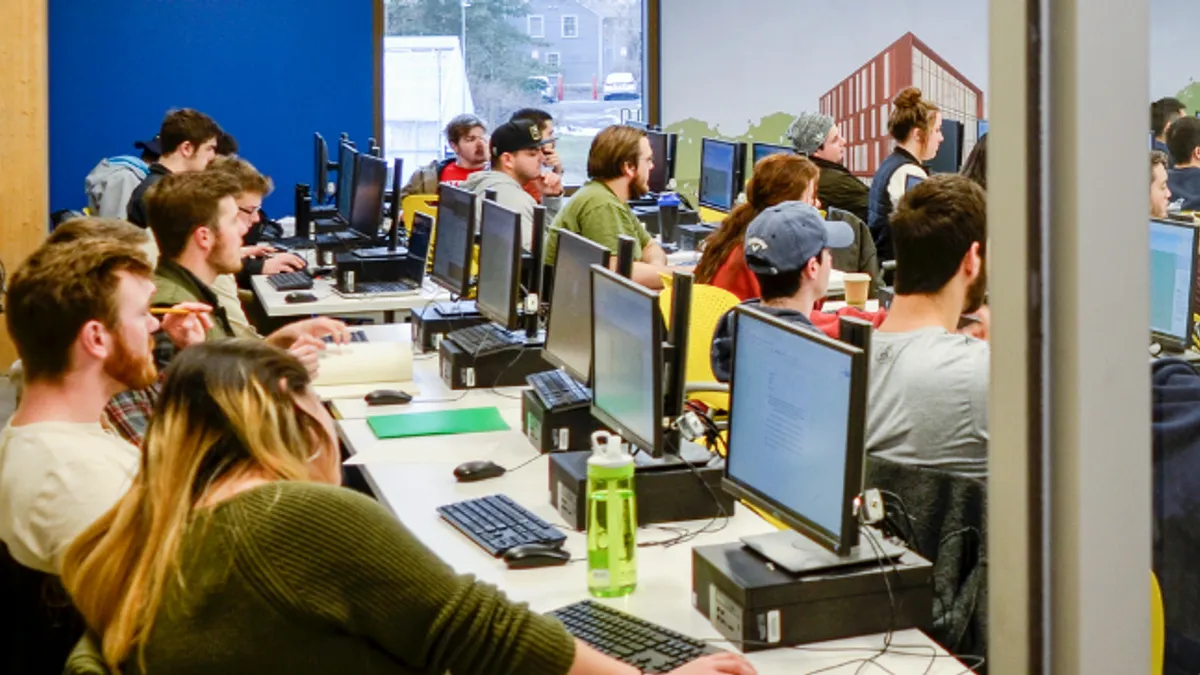Even before the pandemic, the construction industry was facing a severe labor shortage, with nearly 300,000 job vacancies, according to BLS data. But new survey data shows that post-pandemic, the labor crunch may be worse than ever.
How bad? More than 50% of construction firms report being unable to fill craft positions and more than 80% report difficulty finding supervisors or project managers, according to a September 2020 workforce survey conducted by the Associated General Contractors of America and Autodesk. Over the next 12 months, the AGC survey shows that nearly 80% of firms hope to recall or add new employees. But other research shows just how challenging this will be: one in five construction workers are over the age of 55 and for every one new worker entering the field two are retiring.
Those statistics don’t reveal the bigger hurdle facing construction in the coming years — finding workers who know how to operate and optimize technology. In fact, 75% of contractors say unqualified staff and technology adaptations are factors that will most affect the industry over the next 3 years, according to the 2019 JBKnowledge ConTech Report.
For example, the JBKnowledge report notes that nearly 60% of companies state their workforce doesn’t have the skills needed to work BIM. And nearly 40% of firms say “lack of staff to support the technology” is a primary limiting factor to adopting new tech. “The most logical step to bridging the gap is education. There’s an opportunity for “targeted” education topics regarding tech, IT, and BIM,” the report’s authors note.
That’s crucial, because today’s construction jobs don’t just need bodies — they need workers with a combination of construction knowledge and tech skills, like Beth Fulster, a recent Colorado State University grad, now works for Turner Construction where she’s using technology skills she learned in the classroom on the jobsite.
“In the preconstruction graduate-level course, we utilized Trimble’s technology to laser scan a historic building on campus. With the help of Trimble representatives, I was able to learn the process to extract information and interpret the point clouds,” Fulster said. “These experiences at CSU provided me with a solid foundation to stand on as I entered the industry, and I’m confident these tools will help me solve problems and get ahead throughout my career.”
Companies such as Trimble, are helping produce these types of tech-forward employees of the future by partnering with academic institutions via hands-on engagement within two of its outreach programs — Trimble Technology Labs (TTL) and the Visiting Professionals Program (VPP). Much of what’s addressed are workflows in 3D conceptual architectural design, structural design and engineering, and construction management — with a variety of industry-standard solutions including pre-construction cost and schedule estimating, MEP toolsets and content libraries, scan-to-BIM, office-to-field technology, XR hardware and apps, management platforms and much more.
Currently offered at 17 higher education institutions (with another 20 upcoming), TTLs aim to solve the labor shortage challenge within AEC industries by actively integrating a portfolio of Trimble Connected Construction solutions into curricula and research programs, creating a next-gen workforce equipped and empowered to Transform the Way the World Works from office-to-field and back. Having skillsets upon graduation that include Trimble’s integrated solutions, students enter the workforce immediately valued as key contributors and influencers.
“Having a Trimble Technology Lab at UMass Amherst has given our students the software and surveying equipment to elevate their project quality and prepares them well for a technology-based construction industry," said Alexander Schreyer, Director of Building Construction Technology at University of Massachusetts, Amherst.
“When people think about construction, they think about hammers and ladders. But that's not really what we do in construction anymore,” said Anoop Sattineni, associate professor, McWhorter School of Building Science at Auburn University. “It's a highly technological industry. And technology has taken over how we go about communicating and building our structures. The industry is changing a lot faster than what most people in academia are exposed to.”
Trimble’s VPP helps bridge that gap by bringing in industry professionals to expose faculty and students to the latest tech tools employed in context of the construction industry. “It’s interesting to understand how a university’s curriculum is being shaped, how we can influence their curriculum, and the tools they use and learn as they move through their academic lives. It’s been a really good experience to understand how it’s aligned with how we do our business in the industry.,” said Shannon Lightfoot, VDC Manager for McCarthy Building Companies, Inc. and a Trimble visiting professional.
Here’s how it works: the VPP connects Trimble’s professional user community — nearly 30 and counting — with an institution’s area of study. Trimble sends an industry superstar to campus (on their dime) to demonstrate how Trimble solutions are deployed in the professional practices of architecture and design, civil and structural engineering, construction management, or geomatics. The program includes:
- Tech talk lecture. Industry pros walk through their daily work processes, sharing preferred tools and unraveling workflows.
- Hands-on workshops. Students and faculty get their hands dirty with in-depth training and insight into tips and tricks to make workflows easier and more efficient.
- Critiques and pin-ups. Students show the expert what projects they’re working on and get meaningful feedback in a group setting.
“From a student's perspective having the industry professionals visit was really informative and helped us sort of look at how not only we can learn about it [construction technologies], but also how it's used in the industry today,” said Katie Bobo, graduate teaching assistant at McWhorter School of Building Science at Auburn University. “Having industry professionals come in, we really get to see how it's being used in the industry and how we as students can take that in the classroom and apply it to an industry standard.”






